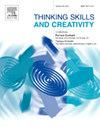帆布和羽毛笔:通过创造性绘画日记提高学生的创造力和写作能力
IF 4.5
2区 教育学
Q1 Social Sciences
引用次数: 0
摘要
本研究开发了“创意绘画日记(CPD)”,将视觉与日记元素系统地结合起来,旨在提高学生的创造性思维和写作能力。采用准实验设计,将48名五年级学生分为实验组(N = 24)和对照组(N = 24)。为确保教学方法的一致性,所有学生由同一位老师授课。在16周的时间里,学生们完成了80篇与教育部课程指南一致的主题日记。关键的区别在于,实验组通过CPD专注于写作和绘画,而对照组只专注于写作。以Amabile的创造力成分理论为基础,CPD方法提供了必要的框架,以增强学生的领域相关知识,创造力相关技能和内在动机。该研究采用了混合方法设计,将创造性思维的定量评估和写作测试与定性访谈结合起来。研究结果表明,实验组的学生在不同的创造性思维维度(即流畅性、灵活性、独创性和阐述)和写作构图(即材料、组织、句子结构、措辞和创造力)上都取得了显著的进步,这与对照组不同。虽然两组的基线非常相似,各方面没有显著差异,但实验组在写作能力(句子结构和创造力)和创造力(流畅性、灵活性、独创性和阐述)方面明显优于对照组。定性研究结果证实了这些结果,强调了持续专业进修课程对学生发展的三个基本特征:定期的写作练习,自由的空间和精神,以及创造性思维策略和材料选择的框架。有力的证据支持视觉和日记元素在课程设计中的整合,这可以显著提高学生的认知和创造能力。本研究为今后的研究和教育实践提供了一个实践性和创新性的框架。本文章由计算机程序翻译,如有差异,请以英文原文为准。
Canvas and quill: Improving students' creativity and writing composition through creative painting diary
This study developed a “Creative Painting Diary (CPD)” to systematically integrate visual and diary-based elements, aiming to enhance students’ creative thinking and writing abilities. A quasi-experimental design was adopted, in which 48 fifth-grade students were assigned to the experimental (N = 24) and comparison groups (N = 24). To ensure consistency in the instructional approach, all students were taught by the same teacher. Over 16 weeks, students completed 80 diaries on topics aligned with the Ministry of Education's Curriculum Guidelines. The key difference was that the experimental group focused on both writing and painting through CPD, whereas the comparison group focused solely on writing composition.
Grounded in Amabile's Componential Theory of Creativity, the CPD approach offers essential scaffolding to enhance students’ domain-relevant knowledge, creativity-relevant skills, and intrinsic motivation. The research employed a mixed-methods design, incorporating quantitative assessment of creative thinking and writing tests alongside qualitative interviews. The findings demonstrated that students in the experimental group achieved significant improvements across different creative thinking dimensions (i.e. fluency, flexibility, originality, and elaboration) and writing composition (i.e. materials, organisation, sentence structure, wording, and creativity), unlike the comparison group. Although the two groups had very similar baselines with no significant differences across all aspects, the experimental group significantly outperformed the comparison group in writing ability (sentence structure and creativity) and creativity (fluency, flexibility, originality, and elaboration). Qualitative findings substantiated these results, highlighting three essential features of the CPD that contributed to students’ development: regular writing practice, free space and ethos, and scaffoldings for creative thinking strategies and material selection. Compelling evidence supports the integration of visual and diary elements in curriculum design, which can significantly enhance students’ cognitive and creative capabilities. This research offers a practical and innovative framework for future studies and educational practices.
求助全文
通过发布文献求助,成功后即可免费获取论文全文。
去求助
来源期刊

Thinking Skills and Creativity
EDUCATION & EDUCATIONAL RESEARCH-
CiteScore
6.40
自引率
16.20%
发文量
172
审稿时长
76 days
期刊介绍:
Thinking Skills and Creativity is a new journal providing a peer-reviewed forum for communication and debate for the community of researchers interested in teaching for thinking and creativity. Papers may represent a variety of theoretical perspectives and methodological approaches and may relate to any age level in a diversity of settings: formal and informal, education and work-based.
 求助内容:
求助内容: 应助结果提醒方式:
应助结果提醒方式:


